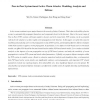192 search results - page 35 / 39 » System Issues in Multi-agent Simulation of Large Crowds |
AAAI
2000
13 years 9 months ago
2000
We consider the use of multi-agent systems to control network routing. Conventional approaches to this task are based on Ideal Shortest Path routing Algorithm (ISPA), under which ...
COMCOM
2008
13 years 7 months ago
2008
Active worms continue to pose major threats to the security of today's Internet. This is due to the ability of active worms to automatically propagate themselves and compromi...
MCS
2008
Springer
13 years 7 months ago
2008
Springer
A stochastic numerical scheme for an extended immersed boundary method which incorporates thermal fluctuations for the simulation of microscopic biological systems consisting of fl...
BROADNETS
2007
IEEE
14 years 1 months ago
2007
IEEE
—Epidemic protocols assume that information of a random set of nodes is provided at each protocol round. By definition, the random set needs to be chosen uniformly and randomly ...
HAPTICS
2008
IEEE
13 years 8 months ago
2008
IEEE
The well known property of haptic interaction is the high refresh rate of the haptic loop that is necessary for the stability of the interaction. Therefore, only simple computation...

